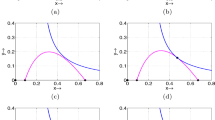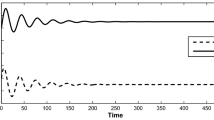Abstract
In this article, we consider a predator–prey system with constant rate of harvesting, which exhibits Hopf and Bogdanov–Takens bifurcations under certain parametric conditions. The parametric space under which the system enters into Hopf bifurcation is investigated. By constructing suitable Lyapunov function, global stability results are obtained. Here, death rate and harvesting rate are taken as the Bogdanov–Takens bifurcation parameters. The canonical form of Bogdanov–Takens bifurcation is derived with the use of repeated nonlinear analytic transformation of coordinates. Later, we include the spatiotemporal effect on the same system and observed some relevant outcomes like Turing pattern, Turing–Bogdanov–Takens bifurcation, Turing–Hopf bifurcation and asynchrony of predator and prey in the space. The present study renders important tools for investigations of the dynamics of biotic organisms (predator and prey) for the management and control of overharvesting. Extensive numerical examples are given in support of the physical existence of the model system under consideration.

















Similar content being viewed by others
References
Clark, C.W.: Bioeconomic Modelling and Fisheries Management. Wiley, New York (1985)
Clark, C.W.: Mathematical Bioeconomics: The Optimal Management of Renewable Resources, 2nd edn. Wiley, New Yourk (1990)
Moitri, S., Srinivasu, P.D.N., Banerjee, M.: Global dynamics of an additional food provided predator-prey system with constant harvest in predators. Appl. Math. Comput. 250, 193–211 (2015)
Haque, Md.M., Sarwardi, S.: Dynamics of a harvested pre-predator model with prey refuge dependent on both species. Int. J. Bifur. Chaos. 25, 1830040 (2018)
Beddington, J.R., May, R.M.: Maximum sustainable yields in systems subject to harvesting at more than one trophic level. Math. Biosci. 51, 261–281 (1980)
Beddington, J.R., Cooke, J.G.: Harvesting from a prey–predator complex. Ecol. Model. 14, 155–177 (1982)
Huang, J., Gong, Y., Ruan, S.: Bifurcation analysis in a predator–prey model with constant-yield harvesting. Discrt. Cont. Dyn. Syst. B 18, 2101–2121 (2013)
Christensen, V.: Managing fisheries involving predator and prey species. Rev. Fish Biol. Fish. 6, 417–442 (1996)
May, R.M., Beddington, J.R., Clark, C.W., Holt, S.J., Laws, R.M.: Management of multispecies fisheries. Science 205, 267–277 (1979)
Huang, J., Gong, Y., Chen, J.: Multiple bifurcations in a predator–prey system of Holling and Leslie type with constant-yield prey harvesting. Int. J. Bifur. Chaos. 23, 1350164 (2013)
Xiao, M., Cao, J.: Hopf bifurcation and non-hyperbolic equilibrium in a ratio-dependent predator–prey model with linear harvesting rate. Anal. Comput. Math. Comput. Model 50, 360–379 (2009)
Makinde, O.D.: Solving ratio-dependent predator–prey system with constant effort harvesting using Adomian decomposition method. Appl. Math. Comput. 186, 17–22 (2007)
Peng, G., Jiang, Y., Li, C.: Bifurcations of a Holling-type II predator–prey system with constant rate harvesting. Int. J. Bifur. Chaos. 19, 2499–2514 (2009)
Ruan, S., Xiao, D.: Global analysis in a predator–prey system with nonmonotonic functional response. SIAM. J. Appl. Math. 61, 14451472 (2001)
May, R.: Stability and Complexity in Model Ecosystems with a New Introduction by the Author. Princenton University Press, Princenton (1973)
Freedman, H.: Deterministic Mathematical Models in Population Ecology. Marcel Dekker, New Yourk (1980)
Akcakaya, H., Arditi, R., Ginzburg, L.: Ratio-dependent predation: an abstraction that works. Ecology 76, 995 (1995)
Conser, C., DeAngelis, D., Ault, J., Olson, D.: Effects of spatial grouping on the functional response of predators. Theor. Popul. Biol. 56, 65 (1999)
Gutierrez, A.: Physiological basis of ratio-dependent predator–prey theory: the metabolic pool model as a paradigm. Ecology 73(5), 155 (1992)
Haque, M.: Ratio-dependent predator–prey models of interacting populations. Bull. Math. Biol. 71, 430 (2009)
Hassell, M.P., Varley, G.C.: New inductive population model for insect parasites and its bearing on biological control. Nature 223, 1133–1137 (1969)
Salt, G.W.: Predator and prey densities as controls of the rate of capture by the predator Didinium nasutum. Ecology 55, 434–439 (1974)
Alonso, D., Bartumeus, F., Catalan, J.: Mutual interference between predators can give rise to Turing spatial patterns. Ecology 83, 28 (2002)
Hwang, Z.W.: Global analysis of the predator–prey system with Beddington–DeAngelis functional response. J. Math. Anal. Appl. 281, 395–401 (2003)
Hwang, Z.W.: Uniqueness of limit cycles of the predator–prey system with Beddington–DeAngelis functional response. J. Math. Anal. Appl. 290, 113–122 (2004)
Beddington, J.R.: Mutual interference between parasites or predators and its effect on searching efficiency. J. Anim. Ecol. 44, 331–340 (1975)
DeAngelis, R.A., Goldstein, R.A., Neill, R.: A model of trophic interaction. Ecology 56, 881–892 (1975)
Birkhoff, G., Rota, G.C.: Ordinary Differential Equations. Ginn Boston, Cambridge (1982)
Hale, J.: Ordinary Differential Equation. Klieger Publishing Company, Malabar (1989)
Bogdanov, R.: Bifurcation of a limit-cycle for a family of vector fields on the plane. Sel. Math. Soviet. 1, 377–388 (1981)
Bogdanov, R.: Versal deformation of a singular point on the plane in the case of zero eigenvalues. Sel. Math. Soviet. 1, 389–421 (1981)
Takens, F.: Forced oscillations and bifurcation. In: Applications of Global Analysis I. Commun. Math. Inst. Rijksuniversitat Utrecht. 3, 1–59 (1974)
Chow, S.N., Hale, J.K.: Methods of Bifurcation Theory. Springer, New York (1982)
Chow, S.N., Li, C.Z., Wang, D.: Normals Forms and Bifurcation of Planar Vector Fields. Cambridge University Press, Cambridge (1994)
Turing, A.M.: On the chemical basis of morphogenesis. Philos. Trans. R. Soc. Lond. B Biol. Sci. 237, 37–72 (1952)
Nicolis, R., Prigogine, I.: Self-Organization in Nonequilibrium Systems. Wiley, New York (1977)
Maini, P., Painter, K., Chau, H.P.: Spatial pattern formation in chemical and biological systems. J. Chem. Soc. Faraday Trans. 93, 3601–3610 (1997)
Winfree, A.T.: Spiral waves of chemical activity. Science 175, 634–634 (1972)
Castets, V., Dulos, E., Boissonade, J., Kepper, P.D.: Experimental evidence of a sustained standing Turing-type nonequilibrium chemical pattern. Phys. Rev. Lett. 64, 2953–2956 (1990)
Waddington, C.H., Perry, M.M.: The ultrastructure of the developing urodele notochord. Proc. R. Soc. Lond. B Biol. Sci. 165, 459–482 (1990)
Gierer, A., Meinhardt, H.: A theory of biological pattern formation. Kybernetic 12, 30–39 (1972)
Rogers, K.W., Schier, A.F.: Morphogen gradients: from generation to interpretation. Annu. Rev. Cell Dev. Biol. 27, 377–407 (2011)
Ouyang, Q., Swinney, H.L.: Transition from a uniform state to hexagonal and striped Turing patterns. Nature 325, 610–612 (1991)
Cross, M.C., Hohenberg, P.C.: Pattern formation outside of equilibrium. Rev. Mod. Phys. 65, 851–1112 (1993)
Segel, L.A., Jackson, J.L.: Dissipative structure: an explanation and an ecological example. J. Theor. Biol. 74, 545–559 (1972)
Medvinsky, A.B., Petrovskii, S.V., Tikhonova, I.A., Malchow, H., Li, B.L.: Spatiotemporal complexity of plankton and fish dynamics. SIAM Rev. 44, 311–370 (2002)
Ghorai, S., Poria, S.: Turing patterns induced by cross-diffusion in a predator–prey system in presence of habitat complexity. Chaos. Sol. Fract 91, 421–429 (2016)
Hu, J.H., Xue, Y.K., Sun, G.Q., Jin, Z., Zhang, J.: Global dynamics of a predator–prey system modeling by metaphysiological approach. Appl. Math. Comput. 283, 369–384 (2016)
Li, L., Jin, Z., Li, J.: Periodic solutions in a herbivore-plant system with time delay and spatial diffusion. Appl. Math. Model. 40, 4765–4777 (2016)
Sun, G.Q., Jin, Z., Liu, Q.X., Li, L.: Pattern formation induced by cross-diffusion in a predator-prey system. Chin. Phys. B 17, 3936–3941 (2008)
Sun, G.Q., Zhang, J., Song, L.P., Jin, Z., Li, B.L.: Pattern formation of a spatial predator–prey system. Appl. Math. Comput. 218, 11151–11162 (2012)
Sun, G.Q., Jin, Z., Li, L., Haque, M., Li, B.L.: Spatial patterns of a predator–prey model with cross diffusion. Nonlinear Dyn. 69, 1631–1638 (2012)
Sun, G.Q., Li, L., Zhang, Z.K.: Spatial dynamics of a vegetation model in an arid flat environment. Nonlinear Dyn. 73, 2207–2219 (2013)
Sun, G.Q., Chakraborty, A., Liu, Q.X., Jin, Z., Anderson, K.E., Li, B.L.: Influence of time delay and nonlinear diffusion on herbivore outbreak. Commun. Nonl. Sci. Numer. Simul. 19, 1507–1518 (2014)
Sun, G.Q., Wang, S.L., Ren, Q., Jin, Z., Wu, Y.P.: Effects of time delay and space on herbivore dynamics: linking inducible defenses of plants to herbivore outbreak. Sci. Rep. 5, 11246 (2015)
Sun, G.Q.: Mathematical modeling of population dynamics with Allee effect. Nonlinear Dyn. 85, 1–12 (2016)
Sun, G.Q., Wu, Z.Y., Wang, Z., Jin, Z.: Influence of isolation degree of spatial patterns on persistence of populations. Nonlinear Dyn. 83, 811–819 (2016)
Kot, M.: Elements of Mathematical Ecology. Cambridge University Press, Cambridge (2001)
Liu, C., Zhang, Q., Zhang, X., Duan, X.: Dynamical behavior in a stage-structured differential-algebraic prey–predator model with discrete time delay and harvesting. J. Comput. Appl. Math. 231, 612–625 (2009)
Sambath, M., Balachandran, K.: Spatiotemporal dynamics of a predator–prey model incorporating a prey refuge. J. Appl. Anal. Comput. 3, 71–80 (2013)
Ma, J., Qin, H., Song, X., Chu, R.: Pattern selection in neuronal network driven by electric autapses with diversity in time delays. Int. J. Mod. Phys. B. 29, 1450239 (2015)
Ma, J., Xu, Y., Ren, G., Wang, C.: Prediction for breakup of spiral wave in a regular neuronal network. Nonlinear Dyn. 84, 497–509 (2016)
Ma, J., Yang, Z., Yang, L., Tang, J.: A physical view of computational neurodynamics. J. Zhejiang Univ. Sci. A. (Appl. Phys. & Eng.) 20, 639–639 (2019)
Malchow, H.: Motional instabilities in predator–prey systems. J. Theor. Biol. 204, 639–647 (2000)
Pascual, M.: Diffusion-induced chaos in a spatial predator–prey system. Proc. Biol. Sci. 251, 0962–8452 (1993)
Wang, C., Ma, J.: A review and guidance for pattern selection in spatiotemporal system. Int. J. Mod. Phys. B. 32, 1830003 (2018)
Medvinsky, A.B.: A periodic patterns in the cellnutrient substrate system. In: Schweitzet, F. (Ed.), Self -Organization of Complex Structures. From Individual to Collective Dynamics, Gordon Breach, London, pp. 269–280 (1997)
Haque, M.: Existence of complex patterns in the Beddington–DeAngelis predator-prey model. Math. Biosc. 239, 179–190 (2012)
Leppnen, T.: Ph.D. Thesis, Helsinki University of Technology, Finland (2004)
Wu, F., Ma, J., Ren, G.: Synchronization stability between initial-dependent oscillators with periodical and chaotic oscillation. J. Zhejiang Univ. Sci. A (Appl. Phys. & Eng.) 19, 889–903 (2018)
Xiao, D., Ruan, S.: Bogdanov–Takens bifurcation in predator–prey systems with constant rate harvesting. Field Inst. Commun. 21, 493–506 (1999)
Ruan, S., Xiao, D.: Global analysis in a predator–prey system with nonmontonic functional response. SIAM J. Appl. Math. 61, 1445–1472 (2001)
Dai, G., Tang, M.: Coexistence region and global dynamics of a harvested predator–prey system. SIAM. J. Appl. Math. 58, 193–210 (1998)
Li, L., Jin, Z.: Pattern dynamics of a spatial predator–prey model with noise. Nonlinear Dyn. 67, 1737–1744 (2012)
Guin, L.N., Acharya, S.: Dynamic behaviour of a reaction-diffusion predator–prey model with both refuge and harvesting. Nonlinear Dyn. 88, 1501–1533 (2017)
Acknowledgements
The authors are grateful to the Department of Mathematics and Statistics, Aliah University, for furnishing opportunities to perform the present work. The authors do appreciate Dr. Mehboob Hoque, Department of Biological Sciences, Aliah University, for his ample help to improve the quality of the manuscript. The corresponding author Dr. Sarwardi is thankful to Dr. Mohd. Hafiz Mohd., School of Mathematical Sciences, Universiti Sains Malaysia, for verifying numerical results of the present refined manuscript.
Author information
Authors and Affiliations
Corresponding author
Ethics declarations
Conflict of interest
The authors declare that they have no conflicts of interests.
Additional information
Publisher's Note
Springer Nature remains neutral with regard to jurisdictional claims in published maps and institutional affiliations.
Rights and permissions
About this article
Cite this article
Sarwardi, S., Haque, M.M. & Hossain, S. Analysis of Bogdanov–Takens bifurcations in a spatiotemporal harvested-predator and prey system with Beddington–DeAngelis-type response function. Nonlinear Dyn 100, 1755–1778 (2020). https://doi.org/10.1007/s11071-020-05549-y
Received:
Accepted:
Published:
Issue Date:
DOI: https://doi.org/10.1007/s11071-020-05549-y




